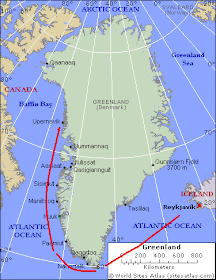In 1434, the Portuguese navigators doubled the dreaded Cape Bojador, just close to home, then they soon connected the Atlantic to the Indian ocean round the Cape of Good Hope and found the route to India ; right, fine, but norse Viking sailors, at least three of them, sailed round cape Farvel (Uummannarsuaq) at 60º N , circumnavigating Greenland by the south end, and reached Kingittorsuaq, a small islet facing the settlement of Upernavik.
And at the time they were yet ... in the Middle Ages (13th century).
That is brave !
They sailed and rowed up to 72° 57′ N. Seventy three degrees north. Something almost unthinkable (The arctic circle is at 63º N).
This was probably the longest distance the Vikings reached northerly bound, in fragile little sail boats (fast though), through an harder Ocean than the South Atlantic - a frozen sea of ice floes and icebergs.
And on they went, until the mythical Helluland told in the Sagas - we know now it was big Baffin Island, already in North America.
The Viking navigators reached further north than was thought, sailing through the Davis Strait, on the West coast of Greenland.
The late 12th century 'Historia Norvegiae' tells us of one of the first encounters of norse hunters with eskimo people in east Greenland:
'On the other side of Greenland, toward the North, hunters have found some little people whom they call skraeling; (...) they have no iron at all; they use missiles made of walrus tusks and sharp stone for knives.'
The Runestone of Kingittorsuaq dates likely from the mid-13th century. It was found in 1824 at the highest point of the island, a group of three piles of stones (cairns) forming an equilateral triangle.
Kingittorsuaq island is no more than an uninhabited rock in Northwest Greenland, on the banks of the Upernavik fjord, near its estuary's opening to Baffin Bay.
The dating of the runestone has varied between 1135 and 1314. It is an almost flat stone with three lines of the Norse characters. Vikings used these inscriptions for various purposes: a memorial to the dead, the marking of territory, or to describe major events (such as travels).
National Museum, Copenhagen
In Greenland alone more than 100 runestones were found. Contrary to some beliefs, none of these testimonies of Norse presence was arguably found in American territory.
So, this is how it was: sometime, by the 13th century, three Viking sailors were on Kingittorsuaq by early spring, having most certainly wintered there. And before departing they left a message, a silent testimony on stone, worked with hands burned and calloused from the intense cold.
And the inscription says:
«Erlingur Sigvatsson, Bjarni Thordarson and Enridi Oddsson erected here three cairns on a Saturday before Rogation day»
[25 April, day of St. Mark in the Christian calendar - an important holiday in medieval times]
On Upernavik, I've posted before here








Vikings went far more north: Skraeling Island in Alexandra Fiord, Ellesmere Island:
ReplyDeletehttp://www.aina.ucalgary.ca/scripts/minisa.dll/144/proe/propub/au+mccullough,+k*+and+rt+any+p?COMMANDSEARCH
Great blog, thank you!
Thank you indeed, Meteorit03, your link is quite interesting and useful.
ReplyDeleteAs far as I know, though, there are no established evidences of norse presence on Ellesmere island or around, the norse findings there are too inconclusive - they might be inuit posessions after trading elsewhere (maybe on Greenland) with Vikings.
Anyhow, your remark is welcome and I'll keep it here.
Considering that the trapper and sailor Ottar sailed from todays County of Troms in northern Norway into the White Sea in Northern Russia at least 250 years before the runestone of Kimgittorsuaq, it is not a huge surprise that they could pull off such adventures. Ottar went on to Hedeby in Denmark and to the court of king Alfred in England, where his story was chronicled. He must have reached about as north as 72°57′N on his travels. There's also some evidence in Icelandic Landnåambok that vilings could have reached Svalbard at 80° N, because the description and the name "Svalbard" fits. But thid remains a theory. Thanks for an interesting blog. Jo
ReplyDelete